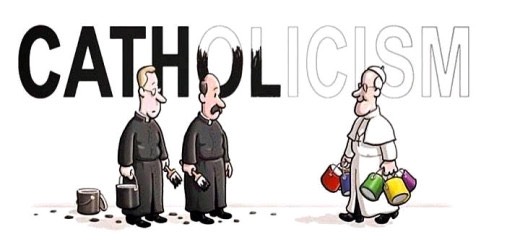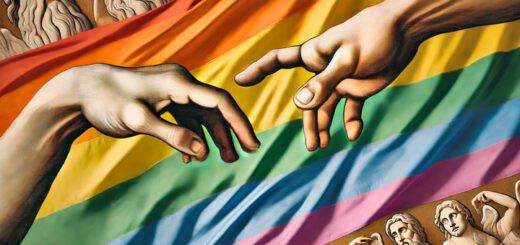What does it mean to be bisexual and Christian?
Reflections by Miriam Samuelson-Raberts* Published on Queer Grace-Encyclopedia for Christians LGBTQ (USA), freely translated by Silvia Lanzi
What is bisexuality? Many define bisexuality as a romantic, emotional sexual orientation, and/or a sexual attraction towards people of more than one sex or gender. Individuals who call themselves bisexuals have a broad spectrum of experiences relating to this type of attraction.
Since bisexuality is an orientation, it embraces feelings and identities, and not only sexual behavior. The sexual orientation of a person does not change according to the kind of those who are attending: for example, a bisexual woman who attends another woman, does not "become" gay or lesbian, but remains bisexual.
Many people who feel attracted to both sexes, or genres, use the termbisexualTo describe, including, but not limiting himself, a PansessualAnd,queer,omnisexual, isfluid. All these terms have the attraction for more of a genre in common. Respecting and listening to the definition that everyone gives their sexual orientation is the first step to help them feel safe and welcome.
What does it mean to be bisexual and Christian? Being bisexual and Christian means that the person in question is, like all people of every gender and sexual orientation identity, a son of God he loved.
Being bisexual in a community can confuse, especially if this does not go beyond gay/lesbian and straight duality. For example, they gladly welcome references to "gay marriage", but this erases the experience of bisexual people. Moreover, the different communities of faith have different educational resources available on bisexuality and therefore have different degrees of knowledge. If it seems that the communities, or individual faithful, are surprised or confused in front of a bisexual person, this does not mean that they cannot understand bisexuality and the ways in which bisexuals are an integral part of the body of Christ. The experience of being bisexuals and Christians vary greatly, and each bisexual Christian will define his orientation and identity in a different way.
Being bisexual means that you can't be monogami? A wrong, and common idea is that bisexuals, intended as a group, are not capable of monogamy. Reverend Janet Edwards wrote about her coming out as a bisexual woman, made when she had around forty-five years of age and another minister of worship who, since she had declared herself bisexual, thought that, implicitly, she had also declared himself non-monogama. Edwards said that it was a disruptive moment for her - he understood that the others played his bisexuality as a declaration on his sexual behavior, while in reality it was a declaration about his identity.
A study lasting ten years, made of the Religious Institute's Resource on Bisexuality, on women who declared themselves bisexuals, showed that 89% had a long -term monogamous relationship. Compared to monogamy, bisexual people are exactly like non-bisexual ones. It is important to remember that bisexuality concerns identity and not a series of pre -established sexual behavior.
What biblical resources can I use to think about my bisexual and Christian being? An important step in reading the Bible and everything that revolves around is to use thehermeneutics, which becomes the interpretative lens through which the sacred book is read. Nobody approaches the scriptures like oneTabula Rasa- We are all formed by our experiences, by the education received and by other factors. The knowledge of the context is the first step to read the Bible responsibly.
A way of going to the bottom with a text is to follow the principles ofhistorical criticism, which looks to the biblical texts in their historical context and in their development over time. Historical criticism tries to understand a text in light of what the author would have originally meant and where this text originates, what are its literary reasons, as has been known and the changes made to it throughout history.
Another useful way of seeing, in particular for people who read the Bible and are interested in LGBTQ topics, is biblical queer criticism. Roaded in the concepts of queer theory, it tries to interpret the biblical texts in a way that disintegrates traditional exegesis and gives a new and less rigid perspective.
A particularly relevant text for bisexual Christians and for those trying to understand bisexuality through the lens of the faith is Galatians 3:28: "There is no longer Jew or Greek, there is no longer a slave or free, there is no longer a man or woman, because you are all in Christ". Many people in a context of Pro-Lgbt faith could add to the list "neither straight nor queer", thus implying that we are more than our differences in the field of sexual identity and orientation.
The text can also be interpreted as an abolition of binarity in general, and the affirmation of the non-binding romantic, emotional and/or type of sexuality with which bisexuals are often identified. Many Christians also interpret it as the affirmation of those who call themselves transsexual.
What can churches do to be more welcoming with those who identify themselves as bisexual? There are many things that ecclesiastical leaders, congregations, friends and communities can do to make churches more welcoming for those who identify themselves as bisexuals. Here are some suggestions:
Create and cultivate a world that goes beyond binarity. The Gospels are full of stories in which Jesus refuses the prescriptions and ways of thinking of his time. By interpreting a text of faith as a community, seek non-bins definitions and go beyond the thought "o/o". Promote a culture at ease with things as a whole and non-bynarity creates a safe space for those who have an orientation neither straight nor gay.
Be careful for the terminology used.Phrases such as "gay and lesbian people", "homosexuals" and "gay marriage" if used in reference to all LGBT individuals, can contribute to the invisibility and cancellation of bisexuals. While in queer communities can vary the favorite way of expressing itself, the acronym LGBTQ is more inclusive of the terms just mentioned and it is preferable to speak of "marriage of people of the same sex" or "marriage of people of the same kind".
Educate to listen to the experiences of others.Use the pro-LGBT resources to learn more about bisexuality and, once done, you will be ready to listen to the experience that others have of their sexual orientation. Education does not give all the answers, but still gives a context from which to start to understand what it means to be bisexual and thus create, in its congregation, a space for opening and knowledge.
Take care and support bisexual people.Bisexuality education includes education on problems which, percentagely, afflict those who are bisexual. As pastoral or secular companions, be sure that your reference list contains LGBTQ-friendly material, and processed to develop the understanding of the complicated feelings involved in each coming out. A 2013 Pew Research study showed that only 25% of those who identify themselves as a bisexual have done with the most important people of their lives. Knowing this reality and preparing to help people who reveal themselves is important to create safe congregations for all LGBTQ people.
In your religious ceremonies given particularly prominence to the different gender identities and the different sexual guidelines.Include litanies, sermons, music, and other elements that underline the welcome of all types of identity and sexual orientation. It could be a litany that celebrates the goodness and dignity of each person, or an anthem written expressly to make LGBTQ voices feel.
*Miriam Samuelson-Raberts is a 2015 graduate from Yale Divinity School. He lives in Minneapolis, and is preparing for the ordination in the Evangelical Lutheran Church American.
Original text:What does it mean to be bisexual and Christian?






